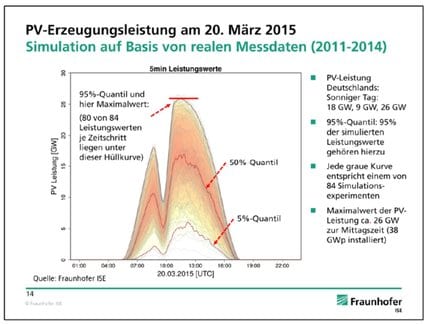On Friday, Germany’s Fraunhofer ISE produced its own short study on the upcoming eclipse along with two videos investigating the best and worst case next Friday morning.
I was not planning to cover the eclipse every day this week, but Fraunhofer’s material is something you will not want to miss.
Unfortunately, the study itself is only available in German (PDF), as are the videos. But the videos are fairly easy to follow. They also differ fundamentally from Professor Volker Quaschning’s. The videos go from 6:30 AM to 1 PM, but the main effects from the eclipse will be from 9:30 AM to around 11 AM.
In contrast to Quaschning’s representation of solar output, which stretched roughly across the 12 hours of daylight, ISE crunches PV production into the full 24-hour cycle, which makes the ramp even steeper. In this chart from the study, we see the missing chunk just before 10 AM. Under the best weather conditions, solar would ramp from around nine GW to 26 GW. Under the worst conditions (“5%-Quantil” in the German), the ramp is more modest at around 1 GW to 5 GW.
In its two videos on the best case (a cloudy day) and worst case (a cloudless day), Germany is divided up into its counties. A different amount of PV is installed in each one, so the videos show how much PV power is produced in a particular geographical area.
The “best case” indicates that the impact on the grid will not be so severe, whereas the “worst” one (without clouds) indicates that grid operators will struggle the most. As I previously indicated, I am hoping for the “worst” case, primarily so we don’t have any excuses (“the only reason there was no blackout was because it was too cloudy anyway”). Professor Burger has flipped around the adjectives, but I can report (based on lunch with him last week) that he is confident that the event is manageable in both cases, though the maximum ramp up is not trivial.
The more official wording from the study (see the conclusions on page 40) state that the ramping ability of the German power plant fleet is “much greater” than the maximum possible PV ramping on a 15-minute basis during the eclipse. Furthermore, wind turbines and PV arrays themselves are able to adjust output and reactive power supply in order to stabilize the grid.
I also received word today that our local utility, Badenova, has invited us to sit in their control room so that we can see how they handle the eclipse live. At the moment, it looks like we will therefore not be reporting from outdoors within Freiburg’s largest array, but from inside the grid control room. And according to the latest weather forecast, this week is to remain quite cloudy up to Friday, with the clouds disappearing completely that day. Brace yourself for Burger’s worst case and my preferred case.
Be sure to follow the discussion on Twitter under #SolarEclipse.
Source: Renewables International. Reproduced with permission.











